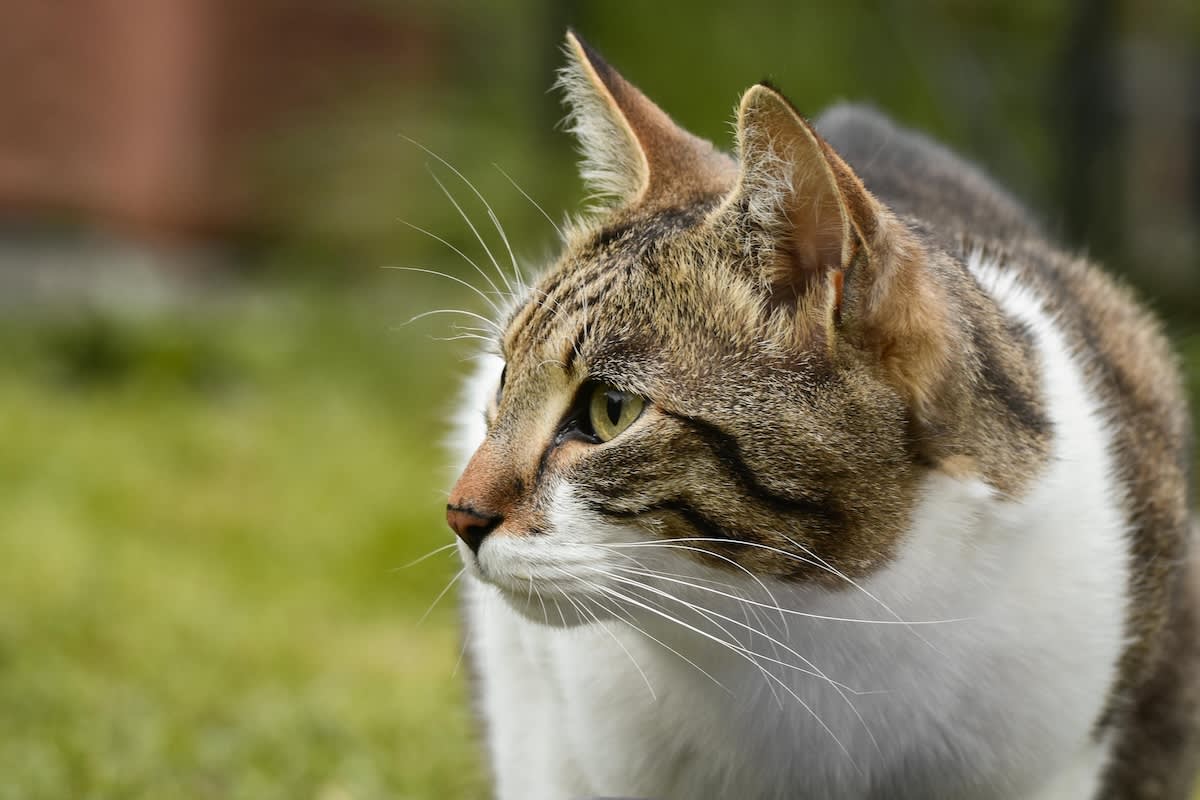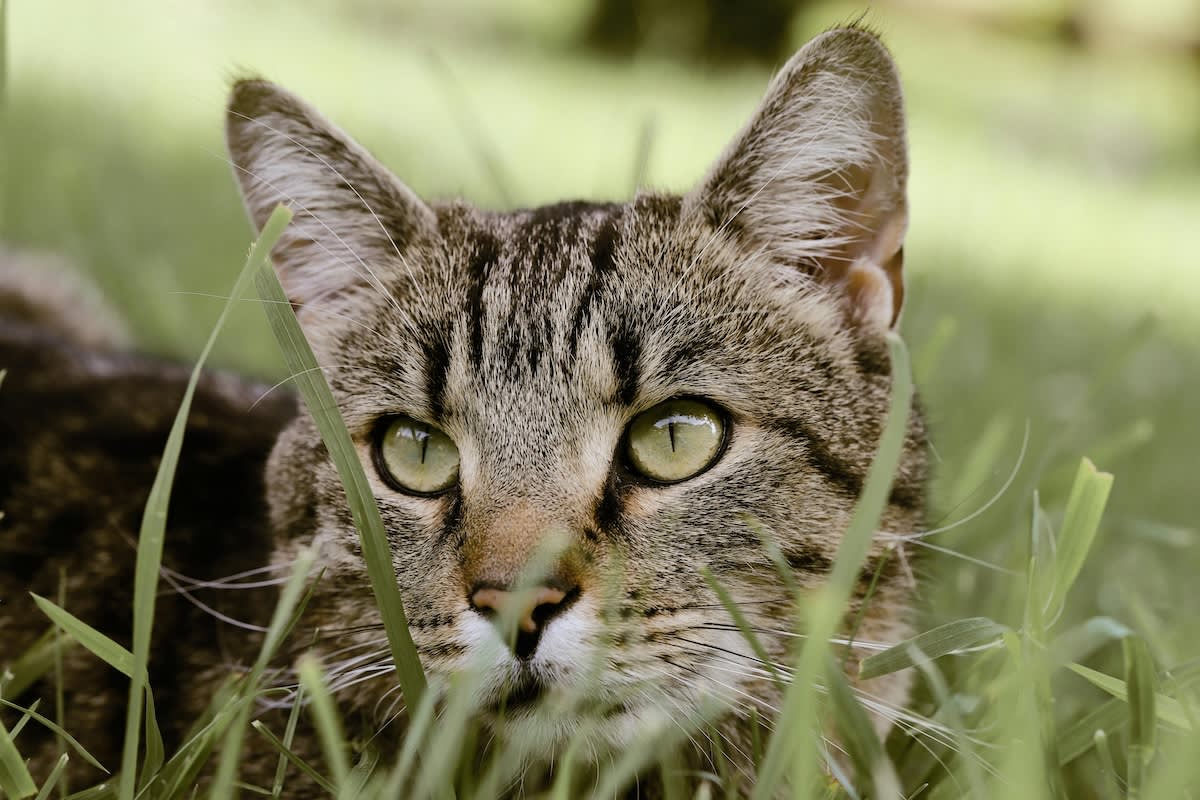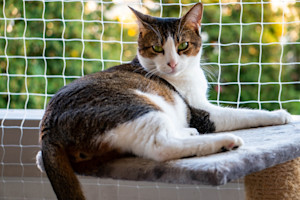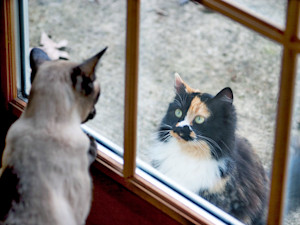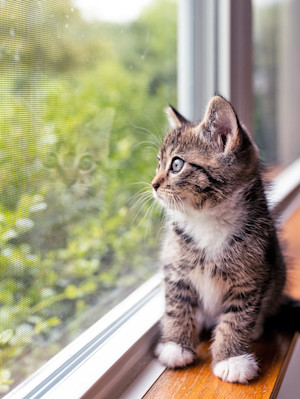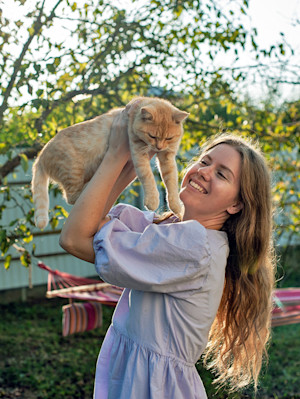I’m a Cat Behaviourist and I’d Never Walk My Cat on a Lead
Those TikTok videos don’t tell the whole story
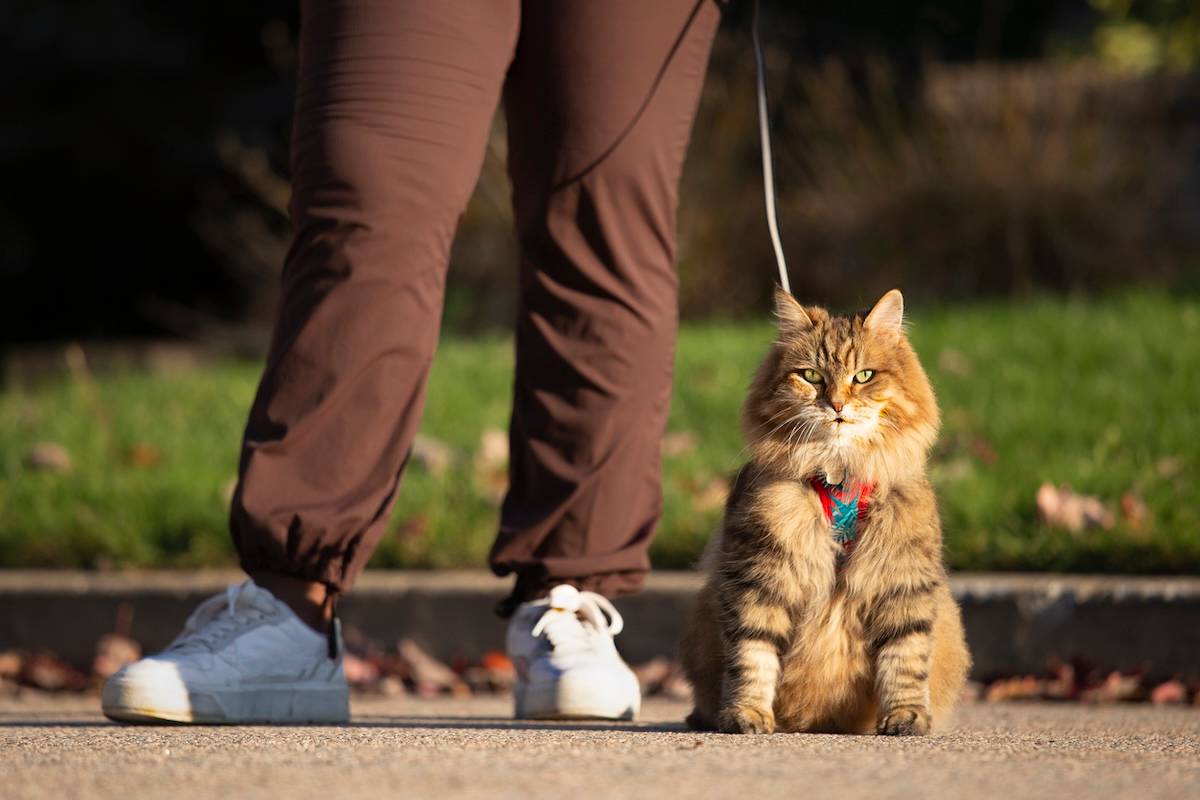
Share Article
I’m a cat behaviourist working with cats (and their humans) across the UK. It’s a job that’s equal parts science, detective work and emotional support. One thing I’ve learned? Most of the behavioural issues I help cat parents resolve could have been avoided with a better understanding of how cats actually think and feel.
That’s why I’ve built up a list of things I’d never do with my own cats. Up near the top? Walking them on a harness and lead. Not because I don’t think cats deserve new experiences. They do. But in most cases, a harness and lead definitely isn’t the way to enhance their lives, no matter what TikTok says. Here’s why.
What is a cat harness and lead?
If you’ve ever searched the hashtag #adventurecat, you’ll have seen cats in harnesses – either webbing loops that fasten around the neck and chest, or fabric jackets that wrap snugly around the body. The idea is simple: strap your cat into the harness, clip on a lightweight lead, and head out for a stroll. Just like a dog.
And that’s where the problem starts – because cats are nothing like dogs.
Why are cat harnesses suddenly everywhere?
According to the Cats and Their Stats UK 2025opens in new tab report from leading UK charity Cats Protection, the percentage of cat parents taking their cats out on harnesses and leads has risen from 10 percent to 15 percent in the past year. There are two main drivers: an increasing number of cats being kept exclusively indoors, and the influence of social media.
TikTok and Instagram are filled with posts featuring harness-wearing cats hiking through forests, paddleboarding or riding across London in bicycle baskets with captions declaring they’re “living their best lives”. The trend has become so mainstream that Transport for London recently shared a video on their Instagram account showing two cats on harnesses and leadsopens in new tab boarding the Elizabeth line. (FWIW, Cats Protection called the video “shocking”opens in new tab and requested TfL take it down, TfL have not compliedopens in new tab thus far).
So, what’s the problem?
That dreamy 15-second reel or perfectly posed photo likely doesn’t tell the full story. What you’re seeing are the highly curated highlights – not the pre-walk panic, mid-walk meltdown, or days of post-walk fallout. Most cats simply aren’t camera-ready urban explorers or enthusiastic wilderness wanderers. They’re homebodies who thrive on routine and predictabilityopens in new tab.
I’m not here to shame anyone who’s tried walking their cat. The intention usually comes from a place of love – wanting to give their cats more freedom, more enrichment, more adventure. That’s a good thing. But cats aren’t small dogs. They’re not pack animals. They don’t look to us for reassurance when they’re scared, and they don’t experience the same kind of pleasure from novel environments or social outings.
Their evolutionary history, body language, and relationship with their environment are fundamentally distinct. Their brains are wired differently. What excites a dog often overwhelms or terrifies a cat. Dogs have stronger attachments to people than to places. Cats are solitary hunters and territorial by nature. They feel most secure in environments they know intimately – places where every sight, sound and scent is familiar. When you take a cat outside on a lead, you’re taking away their sense of control and predictability. They’re suddenly exposed to strange smells, startling sounds, unfamiliar people, cats and dogs – and they’re tethered to you, so they can’t escape.
It doesn’t take much for what you intended to be a fun walk to turn into a traumatic event. Cats can break free or slip out of their harness, dart in front of traffic, get stuck up trees or bolt for cover and get lost. Leads can get tangled around limbs, causing burns, cuts or breaks and sudden jerks on retractable leads can cause neck injuries or strangulation.
I’ve worked with a client whose cat started spraying around the house after an agonistic encounter with an unfamiliar cat during a harness walk outside triggered a territorial stress response. Other cat parents I’ve worked with have been badly scratched and bitten when their cat was lunged at by an off-lead dog, startled by a car alarm or frightened by a snake.
The Five Fs: how cats handle fear
When cats feel overwhelmed, they go into survival mode. This triggers what’s known as the five Fs: five automatic fear responses that help explain why lead walking can go so wrong, so fast.
Flight: run. Escape. Get away from the threat. This is the most common fear response.
Fight: if escape isn’t possible, they may stand their ground and try to repel the threat by hissing, growling, scratching or biting.
Fidget: you might see displacement behaviour – a sudden burst of grooming, lip licking, exaggerated swallowing (when they’re not eating), or obsessive sniffing or scratching. It’s their way of trying to cope when they don’t know what else to do - an out-of-context behaviour that helps them diffuse nervous energy and self-soothe.
Freeze: no movement, wide eyes, crouched posture. People often mistake this for calm or compliance, but it’s actually the nervous system going into shutdown.
Faint: this occurs when a cat’s nervous system becomes so overwhelmed that they completely shut down, becoming physically and mentally unresponsive.
If your cat’s instinct is to flee, but they’re tethered to a lead, their safest escape mechanism is suddenly blocked. That stress doesn’t disappear – it intensifies, and the cat may quickly switch to fight mode. If they’re unable to confront the source of their fear, they are likely to redirect that defensive aggression towards the person holding the lead – you.
Why harnesses can trigger discomfort and stress
Putting a harness on a cat can provoke a stress response before they even step outside. One common sign is the infamous “flop and freeze” – when a cat dramatically collapses to the floor and refuses to move the moment the harness is fastened. It’s not cute or quirky; it’s a clear indication of fear and anxiety.
Cats have extremely sensitive skin and fur. A harness that rubs, applies uneven pressure, or feels restrictive can cause irritation or even pain, especially for cats with fine coats or conditions such as osteoarthritis. While some cats tolerate it, others panic the instant it goes on.
But the issue goes beyond physical discomfort. Cats aren’t just predators - they’re also prey animals. In the wild, being held, pinned or restrained, even slightly, usually signals imminent danger. That sensation of constriction causes a stress responseopens in new tab, sending their nervous system into full-blown survival mode – cue the flight, fight or freeze response. That’s why some cats go completely stiff in a harness, while others flail, flatten or bolt.
Do some cats enjoy walking on a lead?
Possibly, but they’re a small minority. Cats who genuinely seem to enjoy walks on a harness and lead are typically extremely confident, naturally curious and were harness-trained as kittens, using positive reinforcement. They’ve had gradual, consistently positive exposure to the outside world and usually live in quiet areas where they’re unlikely to encounter dogs, traffic or any other stressors. But these cats are the outliers, not the norm.
Most cats, at best, tolerate walks. At worst, they find the experience deeply stressful or frightening. And because feline body language is often subtle, it’s easy to misinterpret what they’re feeling. Just because your cat isn’t yowling or shredding your legs doesn’t mean they’re having a good time.
What about cat backpacks?
Backpacks are often recommended as a backup plan for lead walking. If things go south, just scoop your cat up and pop them in the bag out of harm’s way. But backpacks come with their own risks, especially the popular bubble window types. These are often too small for a cat to lie down or stand up in comfortably, lack adequate ventilation, and offer no place to hide. When your cat is on your back, you can’t monitor their body language or react quickly to protect them from unexpected threats. They’re fully exposed, bouncing around in plain sight of dogs and curious passersby, with no way to retreat. For an animal that thrives on predictability and a sense of control, this setup can be just as stressful as walking on a lead.
So, how should you travel with your cat?
If you need to travel, for example, to the vet, skip the harness and lead and go for a sturdy, well-ventilated plastic cat carrier with a secure door. Line it with a blanket that smells like home and cover it with a towel sprayed with feline pheromones to block out unfamiliar sights and smells.
Safer ways to let your cat experience the outside world
The good news? There are plenty of ways to let your indoor cat to experience the outdoors in a way that feels safe and enriching, without the stress of a harness and lead.
Cat containment fencing: you can cat-proof your garden with barriers that stop them from climbing or jumping out. These either enclose the whole space or attach to the top of existing fencing, giving them safe access to feel the wind in their fur, hide in the undergrowth, stalk insects and sunbathe without the risks of traffic, predators or getting lost.
Supervised garden time: if your garden isn’t escape-proof, you can let your cat explore under your supervision. Stay close, and work on building a strong recall in case they wander too far.
Catios: a cat patio (aka catio) is an enclosed space that lets cats enjoy fresh air and birdwatching safely. You can buy modular set-ups or build one yourself on a patio or balcony.
Window perches: a sunny windowsill offers your cat the perfect vantage point to watch the world go by. It’s like a live-action nature documentary. A strategically placed bird feeder can provide extra enrichment, but be mindful that for some cats, watching prey they can’t catch can cause frustration. To balance this, provide interactive toys indoors that allow them to act on their predatory instincts.
Bring the outdoors in: a log or a piece of driftwood can become a natural cat scratcher. Grow pots of cat grass and catnip, make a sensory box filled with pine cones, feathers, non-toxic dried leaves and shells, or let them investigate a bowl of snow.
Cats on leads: final thoughts
Yes, cats need stimulation, but they also need safety, predictability, choice and control. The outdoors can be enriching, but only when it’s accessed on their terms. For most cats, a walk on a harness and lead is more likely to cause fear and frustration than joy. They don’t want to travel on the Tube or climb a mountain. They want to patrol familiar territory, feel secure enough to snooze on the grass in the sunshine, and rule their kingdom from the top of the cat tree.
References
Amat, Marta, et al. “Stress in Owned Cats: Behavioural Changes and Welfare Implicationsopens in new tab.” Journal of Feline Medicine and Surgery, vol. 18, no. 8, June 2015, pp. 577–86, https://doi.org/10.1177/1098612x15590867.
Cats Protection. “CATS Report Cats and Their Stats UK 2025opens in new tab.” Cats.org.uk, Cats Protection, Sept. 2025, www.cats.org.uk/media/onnnmi1h/cats-report-uk-2025_digital.pdf.
Moody, Carly M., et al. “Can You Handle It? Validating Negative Responses to Restraint in Catsopens in new tab.” Applied Animal Behaviour Science, vol. 204, July 2018, pp. 94–100, https://doi.org/10.1016/j.applanim.2018.04.012.

Claire Stares, BA (Hons), MA, PG Dip Clinical Animal Behaviour
Claire Stares is a feline behaviourist with a PG Diploma in Clinical Animal Behaviour from the University of Edinburgh Royal (Dick) School of Veterinary Studies. She’s dedicated to helping guardians and their cats overcome behavioural problems and thrive so that they can enjoy life together. A cat lady since babyhood (her first word was cat!), she has over 20 years of experience living and working with cats in homes, rescue environments and veterinary practices. A passionate advocate for training cats for enrichment and cooperative care, she practices what she preaches with her five cats: three rescued Domestic Shorthairs, Bimble, Bertie and Katie, a Siamese called Daisy Mae, and a Maine Coon named Horatio. When there isn’t a feline companion asleep on her laptop, she writes books and articles for various publications.
Related articles
![a picture of a cat on a cat tree outside in a catio]()
More Pet Parents Are Getting Catios… Should You?
And how much do they cost?
![]()
Should My Kitty Be An Indoor Or Outdoor Cat?
All the info you need to make this crucial decision
![]()
When Can My Kitten Go Outside in the UK?
If you’d like your kitten to grow up with outdoor access, here’s what to know to help keep them safe
![]()
How To Create a Cat-Safe Garden
Green fingers at the ready
![A woman with tattoos hugging her white cat in a cluttered, art-filled room]()
How to Stop Your Outdoor Cat From Moving in With Your Neighbours
Thanks to your neighbour’s treats, your kitty’s over-the-fence visits are starting to become uncomfortably regular...

